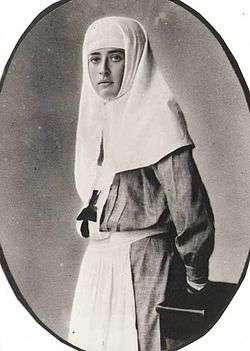Russian hospital ship Portugal
 Russian hospital ship Portugal | |
| History | |
|---|---|
| Name: | Portugal |
| Owner: | Brazil and River Plate Line |
| Operator: | Imperial Russian Navy |
| Builder: | Messageries Maritimes Company, La Ciotat |
| Yard number: | 63 |
| Launched: | July 1886 |
| Fate: |
Sunk by a torpedo from the U-boat U-33 on March 30 [O.S. March 17] 1916.[1] |
| General characteristics | |
| Tonnage: | 5,549 tons gross |
Russian hospital ship Portugal (Russian: госпитальное судно "Португаль") was a steam ship originally built by a French shipping company, but requisitioned for use as a Russian hospital ship during the First World War. On March 30 [O.S. March 17] 1916 she was sunk by a torpedo from the German U-boat U-33.[2]
History
She was originally built in 1886 for the Brazil and River Plate Line of the Messageries Maritimes Company. She was chartered or purchased by the Russians for use as a hospital ship in the Black Sea.
Sinking

March 30 [O.S. March 17] 1916, 1916 the Portugal was towing a string of small flat-bottomed boats to ferry wounded from the shore to the ship. Off Rizeh, on the Turkish coast of the Black Sea, she had stopped as one of the small boats was sinking and repairs were being made. The ship was not carrying wounded at the time, but had a staff of Red Cross physicians and nurses on board, as well as her usual crew.[3]
The ship's crew saw a periscope approaching the vessel but as the ship was a hospital ship and protected by the Hague conventions no evasive actions were taken. Without warning the submarine fired a torpedo which missed. The U-boat, U-33, came around again fired a torpedo from a distance of 30 feet, which hit near the engine room, breaking the ship into two pieces.[3]
The Vperiod
On July 8 [O.S. June 25] 1916, another Russian hospital ship, named Vperiod (Вперёд; also transcribed, French-style, as Vperiode) was sunk between Rizeh and Batum, allegedly by German U-boat U-38. The boat was not carrying wounded, as it was on its trip to the frontline. Seven people died, the rest were saved.[4]
The Russian government claimed that Turkish forces sank the Portugal,[5] and the Vperiod.[6] The Turkish government replied that both ships were sunk by mines.[5]
See also
References
- ↑ NY Times article directly after incident, retrieved Dec 31, 2009
- ↑ Helgason, Guðmundur. "Ships hit during WWI: Portugal". German and Austrian U-boats of World War I - Kaiserliche Marine - Uboat.net. Retrieved August 29, 2009.
- 1 2 The War on hospital ships, from the narratives of eye-witnesses (1917) (1917 ed.). London : T. Fisher Unwin. p. 1. - Call number: SRLF_UCLA:LAGE-3563453
- ↑ П.Г.Усенко (P.G.Usenko), IСТОРIЇ ВЕЛИКОЇ ВIЙНИ 1914–1917 рр. НА ЧОРНОМУ МОРI (From the history of the Great War of the 1914-1917 on the Black Sea). Page 80. (Ukrainian)
- 1 2 Cemalettin Taskiran (1 March 2003). "Allied Attacks On Turkish Patients & Wounded". The Journal of the Turkish Weekly. Retrieved August 28, 2009.
- ↑ "Peace Movement Diverts Attention at Year's End from Battlefields to Chancelleries of Belligerents and Principal Neutral Capitals." (PDF). The New York Times. December 31, 1916. Retrieved August 24, 2009.
External links
| Wikimedia Commons has media related to Portugal (ship, 1886). |
- Le paquebot PORTUGAL des Messageries Maritimes (French)
- Russian wounded moved to the hospital ship Portugal; rescued wounded soldiers and sailors after the sinking on YouTube
Coordinates: 42°00′36″N 41°11′24″E / 42.01000°N 41.19000°E